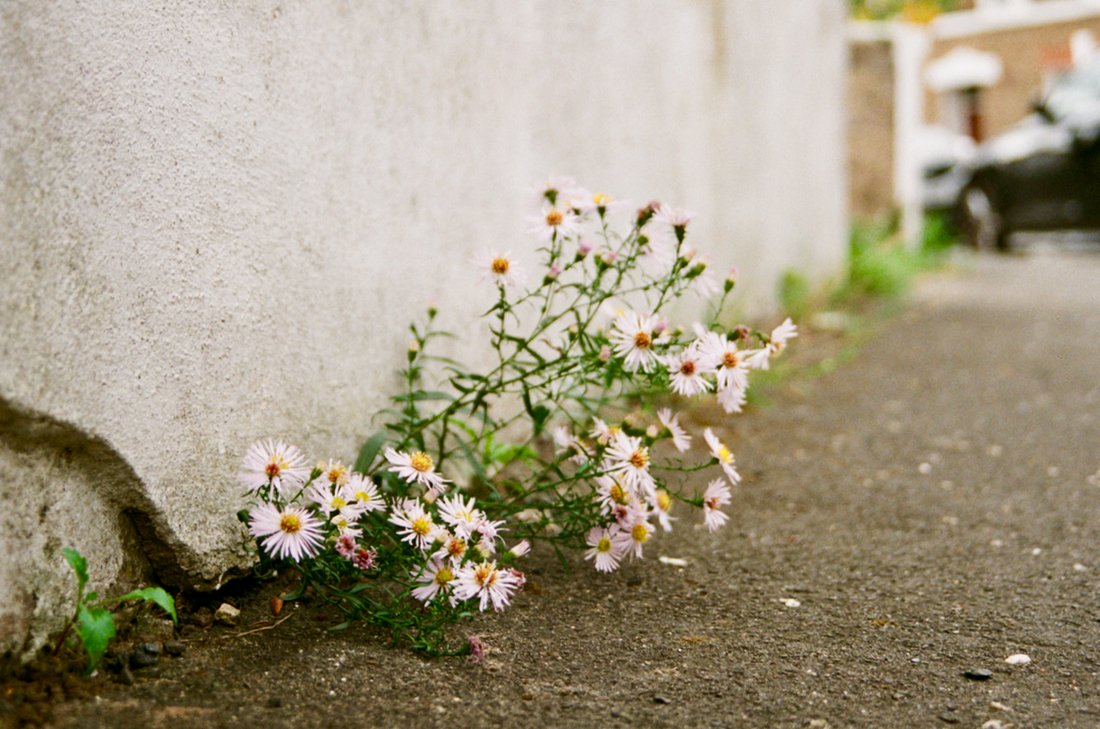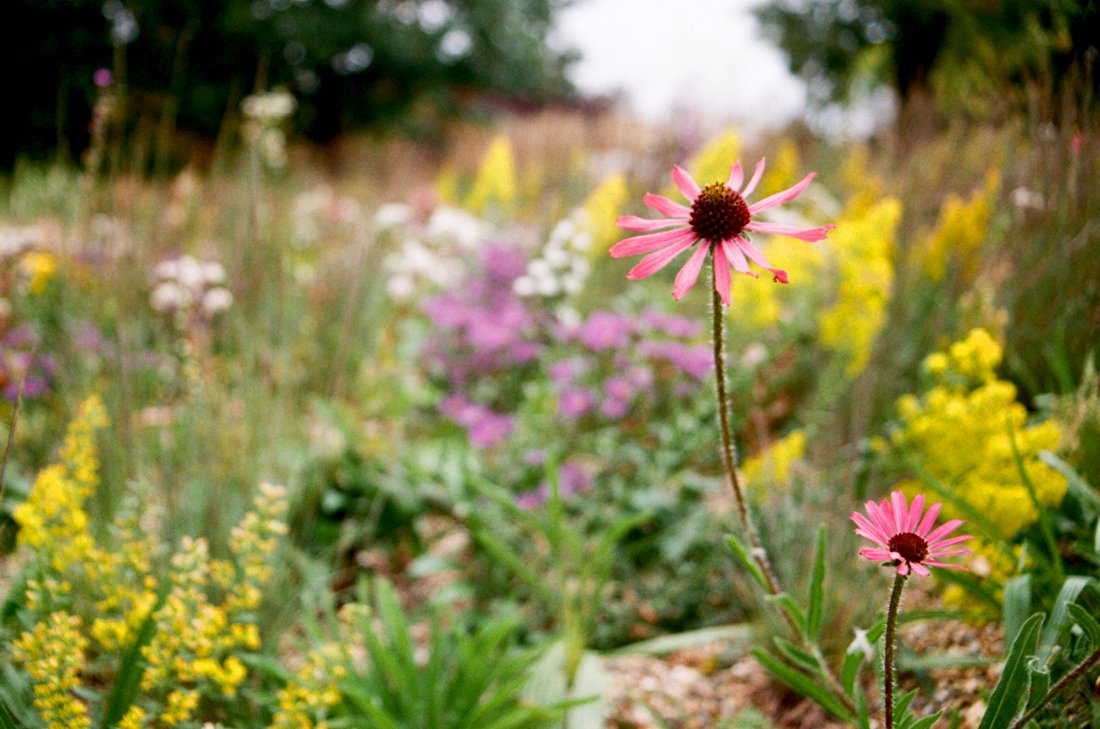
Matt Collins, writer and Head Gardener at The Garden Museum in Lambeth, delights in the current abundance of road-side daisies...
The summer is well and truly over the summer that broke sweats, reservoirs and records and for a good long month England has experienced days of modest, gardener-friendly temperatures remaining comfortably below the 20 celsius mark.
But while our gargantuan Mediterranean, super-summer is past, it is not, it would seem, forgotten. Early autumn bore visible mementos of the extreme and sustained heat: premature fruit harvests, flash flooding, lawns like worn old rugs.
In particular, two definitive sunshine souvenirs impressed firmly upon me a few weeks back, during a mid-afternoon walk around my neighbourhood in South London. Firstly, the number of grasshoppers I flushed from the grass when traipsing through a local park I don't recall ever before encountering so many this side of the Channel and secondly, Asters; an urban onslaught of Michaelmas daisies spilling from every pavement, fence rail and pothole in the borough.
It isn't as though I hadn't seen this coming, watching for some weeks the steady rise and accumulation of robust stalks and clustered buds infiltrating our concrete, but all of a sudden some time perhaps around September 29th, the Feast of Saint Michael, as is tradition they all opened at once, engulfing the front gardens of our entire London district in a torrent of pink and blue.
Circling back from my walk I cut a short roadside stem, took it home and placed it in a milk bottle on the windowsill, where it has remained in constant and mesmerising bloom for well over a week. The sweltering months may have prompted a bumper year for apples but, unquestionably, it's been an exceptional one for Asters, too.


Strictly speaking these star-clustered sprays (or Starworts') are an assorted integration of the Northern Hemisphere's most promiscuous species. Alongside the China aster (Callistephus chinensis) and the rampant European aster (A. amellus), garden varieties include numerous hybrids that stem from two key American species, novi-belgii and novae-angliae.
Somewhat confusingly, in the late 19th Century these tall yet simple, blue-lavender-white flowers were reclassified with the genus Symphyotrichum given their unique appearance among asters much the same as the wood aster (formerly A. divaricata) has a comparatively short history under the genus, Eurybia. Symphyotrichum asters hail from the eastern states of America, though grow as far west as the Rocky Mountains, inhabiting a range of environments from woodland glades and field margins to dry open pasture.
In that wonderful, mysterious symbiosis found so often in nature, their species open just in time to supply food for the colossal intercontinental autumn migration of monarch butterflies, opening with a spring like profusion', as garden designer Gertrude Jekyll once put it, when all else is on the verge of death and decay'.
And just like the European asters, these flowers are at their most energised following a long hot summer; indeed there has been something distinctly American about the climate here these past few months.


Inspired by the Michaelmas swathes on my doorstep, and with the rare fortune of a free afternoon, I decided to visit the Horniman museum in Forest Hill.
At the tail end of last year, the Horniman engaged leading horticultural ecologist James Hitchmough (known for his London Olympic Park planting) in creating two large grassland' display beds in the museum gardens, emulating the kind of natural plant communities found in the prairies of South Africa and North America.
I felt confident the beds would be looking pretty good if the staggering popularity of prairie planting in recent years has taught us anything, it's that its charms often peak at the arrival of autumn and this was certainly the case.
Echinacea, Berkheya, Kniphofia, and, of course, asters projected from the beds in a striking array of brilliant colours, having seized their new footholds with remarkable fervour and begun to spread attractively, one into the other.
Hitchmough's exercise at the Horniman serves a dual purpose however; it is beautiful and considered planting, but also a stark reminder of our worryingly changing climate.
While centuries of disturbance and agro-industry have depleted the Earth's wild grasslands (thought to have once covered a quarter of the globe), and continue to endanger what remains of those indigenous to America and southern Africa, rising temperatures now bring to question the kind of plants that will thrive in our warming British countryside and gardens.
The grassland beds exhibit a compellingly arid-loving alternative to the quintessential, well-mulched English herbaceous border. And if you needed any more convincing, there are much larger grassland beds at Oxford Botanic Gardens, similarly conceived by James Hitchmough, now well-established following ten years of steady development.
The Merton Borders' were sown from seed in 2008, and encompass a vast patchwork of floral communities including mallows, diascias, thistles, soaring Stipa gigantea and bright yellow Silphium terebinthinaceum. They are an and I hesitate to use this word epic display of a kind of planting that seems to be increasingly at home in the soil of our southern counties.

As gardeners, if we are to uphold the grand slogan of right place, right plant', we will need to adapt alongside what we observe in the natural world.
Earlier in the summer, during the gathering heatwave, I visited Dungeness in Kent and was overwhelmed by the sight of wild echiums (viper's bugloss') and field poppies spread out over the beach shingle there. It gave me a new found respect for the echiums that self-seed into paving cracks at the Garden Museum, where I garden; they're happy there in the dry, free-draining soil and will flower better than most so why would I think of removing them?

The proliferation of asters this last month made an impression on me no doubt, in part, because healthy-looking plants are always a pleasure to encounter. Like so many gardeners particularly those maintaining gardens in London and the wider south-east, I have spent a great deal of this year bearing witness to a mass expiration; so many cultivated plants waning, wilting, withering and dying under the extraordinary heat.
The wild Michaelmas flush, on the other hand, with its virile rampage of bright blue stars and forceful dominance over the streets of South London, is pure joy. It will remain a lasting vision with which to remember this scorching summer, and a reminder to better observe what is flourishing beyond the garden fence.
Words and images by Matt Collins


Add a comment